SiO2 Microsphere Array Coated by Ag Nanoparticles as Raman Enhancement Sensor with High Sensitivity and High Stability
Abstract
:1. Introduction
2. Materials and Methods
2.1. Materials and Characterization Equipment
2.2. Preparation of the SERS Substrate
2.2.1. Preparation of Silver Sol with Different Particle Sizes
2.2.2. Preparation of Monolayer SiO2 MS
2.2.3. Preparation of Monolayer Ag@SiO2 Substrate
3. Results
3.1. SEM Characterization
3.2. UV–Vis Absorption
3.3. Raman Measurements
3.3.1. FDTD Simulation
3.3.2. Raman Measurements with Different R6G Concentrations
3.3.3. Uniformity
3.3.4. Multi-Molecular Detection
4. Conclusions
Author Contributions
Funding
Institutional Review Board Statement
Informed Consent Statement
Data Availability Statement
Acknowledgments
Conflicts of Interest
References
- Li, Q.Q.; Gong, S.S.; Zhang, H.; Huang, F.Z.; Zhang, L.N.; Li, S.K. Tailored necklace-like Ag@ZIF-8 core/shell heterostructure nanowires for high-performance plasmonic SERS detection. Chem. Eng. J. 2019, 371, 26–33. [Google Scholar] [CrossRef]
- Li, J.J.; Yan, H.; Tan, X.C.; Lu, Z.C.; Han, H.Y. Cauliflower-inspired 3D SERS substrate for multiple mycotoxins detection. Anal. Chem. 2019, 91, 3885–3892. [Google Scholar] [CrossRef] [PubMed]
- Zhang, Y.; Yao, L.H.; Liu, L.X.; Peng, Z.H.; Li, Z.P.; Wang, H.; Zhou, Q.J.; Wei, T.; Guo, Y.R.; Yang, X.; et al. Shape-diversified silver nanostructures on Al foil fabricated in micellar template for high performance surface enhanced Raman scattering applications. Opt. Mater. 2021, 121, 111629. [Google Scholar] [CrossRef]
- Lombardi, J.R.; Birke, R.L. A unified view of surface-enhanced Raman scattering. Acc. Chem. Res. 2009, 42, 734–742. [Google Scholar] [CrossRef] [Green Version]
- Sasahara, A.; Hiehata, K.; Onishi, H. Metal-to-oxide charge transfer observed by a kelvin probe force microscope. Catal. Surv. Asia 2009, 13, 9–15. [Google Scholar] [CrossRef]
- Zhang, J.; Yin, Z.H.; Zhang, X.L.; Zhu, Y. Quantitative SERS by electromagnetic enhancement normalization with carbon nanotube as an internal standard. Opt. Express 2018, 26, 23534–23539. [Google Scholar]
- Pang, R.; Zhang, X.G.; Zhou, J.Z.; Wu, D.Y.; Tian, Z.Q. SERS chemical enhancement of water molecules from halide ion coadsorption and photoinduced charge transfer on silver electrodes. J. Phys. Chem. C 2017, 121, 10445–10454. [Google Scholar] [CrossRef]
- Zhang, D.; Liang, P.; Yu, Z.; Huang, J.; Ni, D.; Shu, H.B.; Dong, Q.M. The effect of solvent environment toward optimization of SERS sensors for pesticides detection from chemical enhancement aspects. Sens. Actuator B-Chem. 2018, 256, 721–728. [Google Scholar] [CrossRef]
- Zokaei, M.; Abedi, A.S.; Kamankesh, M.; Shojaee-Aliababadi, S.; Mohammadi, A. Ultrasonic-assisted extraction and dispersive liquid-liquid microextraction combined with gas chromatography-mass spectrometry as an efficient and sensitive method for determining of acrylamide in potato chips samples. Food Chem. 2017, 234, 55–61. [Google Scholar] [CrossRef]
- Liu, J.W.; Hong, Z.L.; Yang, W.M.; Liu, C.; Lu, Z.C.; Wu, L.; Foda, M.F.; Yang, Z.; Han, H.Y.; Zhao, Y.L. Bacteria inspired internal standard SERS substrate for quantitative detection. ACS Appl. Bio Mater. 2021, 4, 2009–2019. [Google Scholar] [CrossRef]
- Weng, G.J.; Yang, Y.; Zhao, J.; Li, J.J.; Zhu, J.; Zhao, J.W. Improving the SERS enhancement and reproducibility of inkjet-printed Au NP paper substrates by second growth of Ag nanoparticles. Mater. Chem. Phys. 2020, 253, 123416. [Google Scholar] [CrossRef]
- Schuth, F. Controlled nanostructures for applications in catalysis. Phys. Chem. Chem. Phys. 2011, 13, 2447–2448. [Google Scholar] [CrossRef]
- Panacek, A.; Kvitek, L.; Prucek, R.; Kolar, M.; Vecerova, R.; Pizurova, N.; Sharma, V.K.; Nevecna, T.; Zboril, R. Silver colloid nanoparticles: Synthesis, characterization, and their antibacterial activity. J. Phys. Chem. B 2006, 110, 16248–16253. [Google Scholar] [CrossRef]
- Han, B.; Choi, N.; Kim, K.H.; Lim, D.W.; Choo, J. Application of silver-coated magnetic microspheres to a SERS-based optofluidic sensor. J. Phys. Chem. C 2011, 115, 6290–6296. [Google Scholar] [CrossRef]
- Mi, Y.L.; Yan, Y.Z.; Wang, M.Y.; Yang, L.X.; He, J.; Jiang, Y.J. Cascaded microsphere-coupled surface-enhanced Raman spectroscopy (CMS-SERS) for ultrasensitive trace-detection. Nanophotonics 2022, 11, 559–570. [Google Scholar] [CrossRef]
- Chen, K.H.; Pu, Y.C.; Chang, K.D.; Liang, Y.F.; Liu, C.M.; Yeh, J.W.; Shih, H.C.; Hsu, Y.J. Ag-nanoparticle-decorated SiO2 nanospheres exhibiting remarkable plasmon-mediated photocatalytic properties. J. Phys. Chem. C 2012, 116, 19039–19045. [Google Scholar] [CrossRef] [Green Version]
- Tian, Y.; Qi, J.J.; Zhang, W.; Cai, Q.; Jiang, X.Y. Facile, One-pot synthesis, and antibacterial activity of mesoporous silica nanoparticles decorated with well-dispersed silver nanoparticles. ACS Appl. Mater. Interfaces 2014, 6, 12038–12045. [Google Scholar] [CrossRef]
- Zhao, W.N.; Wu, Y.Y.; Liu, X.G.; Xu, Y.B.; Wang, S.B.; Xu, Z.M. The fabrication of polymer-nanocone-based 3D Au nanoparticle array and its SERS performance. Appl. Phys. A-Mater. Sci. Process. 2017, 123, 45. [Google Scholar] [CrossRef]
- Wang, K.Q.; Sun, D.W.; Pu, H.B.; Wei, Q.Y. Polymer multilayers enabled stable and flexible Au@Ag nanoparticle array for nondestructive SERS detection of pesticide residues. Talanta 2021, 223, 121782. [Google Scholar] [CrossRef]
- Wu, H.R.; Zhou, X.C.; Li, J.D.; Li, X.M.; Li, B.W.; Fei, W.W.; Zhou, J.X.; Yin, J.; Guo, W.L. Ultrathin molybdenum dioxide nanosheets as uniform and reusable surface-enhanced Raman spectroscopy substrates with high sensitivity. Small 2018, 14, 1802276. [Google Scholar] [CrossRef]
- Chen, J.F.; Li, T.; Zhang, J. Raman enhancement properties of a high uniformity PS microsphere-Ag nanoparticle substrate. Opt. Mater. Express 2020, 10, 3215–3225. [Google Scholar]
- Lu, Y.; Mei, Y.; Drechsler, M.; Ballauff, M. Thermosensitive core–shell particles as carriers for Ag nanoparticles: Modulating the catalytic activity by a phase transition in networks. Angew. Chem. Int. Edit. 2006, 45, 813–816. [Google Scholar] [CrossRef]
- Kim, H.M.; Jeong, D.H.; Jeong, S.; Hahm, E.; Kang, H.; Pham, X.H.; Lee, Y.S. Large scale synthesis of surface-enhanced Raman scattering nanoprobes with high reproducibility and long-term stability. J. Ind. Eng. Chem. 2016, 33, 22–27. [Google Scholar] [CrossRef]
- Chang, H.J.; Kang, H.M.; Ko, E.; Jun, B.H.; Lee, H.Y.; Lee, Y.S.; Jeang, D.H. PSA detection with femtomolar sensitivity and a broad dynamic range using SERS nanoprobes and an area-scanning method. ACS Sens. 2016, 1, 645–649. [Google Scholar] [CrossRef]
- Pham, X.H.; Lee, M.; Shim, S.; Jeong, S.; Kim, H.M.; Hahm, E.; Lee, S.H.; Lee, Y.S.; Jeong, D.H.; Jun, B.H. Highly sensitive and reliable SERS probes based on nanogap control of a Au-Ag alloy on silica nanoparticles. RSC Adv. 2017, 7, 7015–7021. [Google Scholar] [CrossRef] [Green Version]
- Bastus, N.G.; Merkoci, F.; Piella, J.; Puntes, V. Synthesis of highly monodisperse citrate-stabilized silver nanoparticles of up to 200 nm: Kinetic control and catalytic properties. Chem. Mat. 2014, 26, 2836–2846. [Google Scholar] [CrossRef]
- Le Ru, E.C.; Etchegoin, P.G. Principles of Surface Enhanced Raman Spectroscopy and Related Plasmonic Effects, 1st ed.; Elsevier: Oxford, UK, 2009; pp. 361–365. [Google Scholar]
- Luk’yanchuk, B.; Zheludev, N.I.; Maier, S.A.; Halas, N.J.; Nordlander, P.; Giessen, H.; Chong, C.T. The Fano resonance in plasmonic nanostructures and metamaterial. Nat. Mater. 2010, 9, 707–715. [Google Scholar] [CrossRef]
- Palik, E.D. Handbook of Optical Constants of Solids, 3rd ed.; Elsevier: Washington, DC, USA, 1985; pp. 350–357. [Google Scholar]
- Chen, J.; Chen, H.X.; Zhang, J.; Zhu, Y. Raman enhancement properties of Ag nano-islands with SiO2 microsphere array prepared by self-assembly technology and thin-film annealing method. Opt. Mater. Express 2021, 11, 2076–2088. [Google Scholar]
- Liu, C.; Su, Q.Q.; Li, L.; Sun, J.; Dong, J.; Qian, W.P. Substrate-immersed solvothermal synthesis of ordered SiO2/Ag arrays as catalytic SERS substrates. Nano 2018, 13, 1850049. [Google Scholar] [CrossRef] [Green Version]
- Li, J.F.; Xu, Y.F.; Tian, L.L.; Yan, Y.B.; Niu, L.Y.; Li, X.H.; Zhang, Z.J. Silver nanoparticle-decorated silica nanospheres and arrays as potential substrates for surface-enhanced Raman scattering. ACS Omega 2021, 6, 32879–32887. [Google Scholar] [CrossRef] [PubMed]
- Huang, J.; Zhou, Y.F.; Xu, J.; Liang, P.; Liu, Z.G.; Wang, J.; Zhang, D.; Dong, Q.M.; Shen, W.M.; Zhuang, S.L. Unveiling the growth mechanism of SiO2/Ag hybrid nanospheres and using for surface enhanced Raman scattering detection. Appl. Surf. Sci. 2019, 463, 115–120. [Google Scholar] [CrossRef]
- Chen, J.; Gong, Y.; Shang, J.; Li, J.; Wang, Y.; Wu, K. Two-dimensional Ag nanoparticle tetramer array for surface-enhanced Raman scattering measurements. J. Phys. Chem. C 2014, 118, 22702–22710. [Google Scholar] [CrossRef]
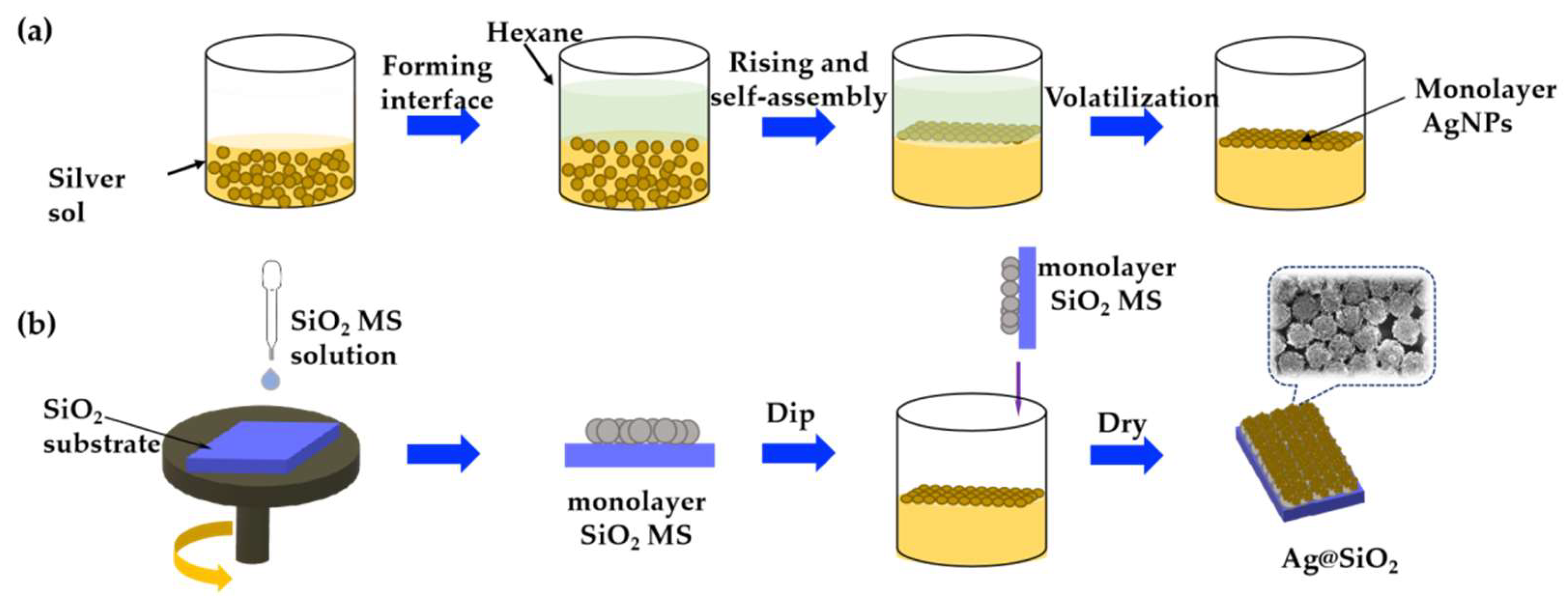
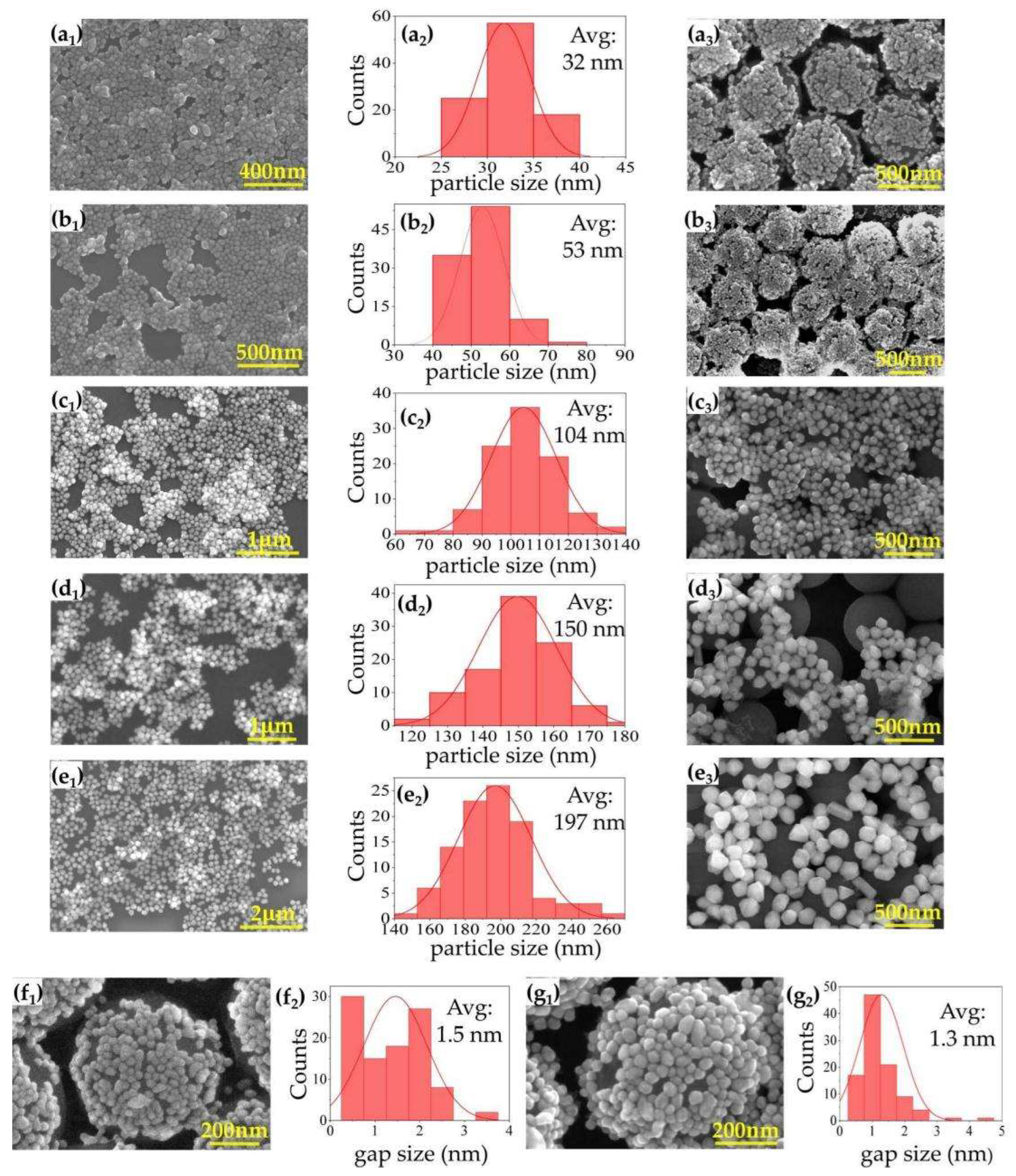
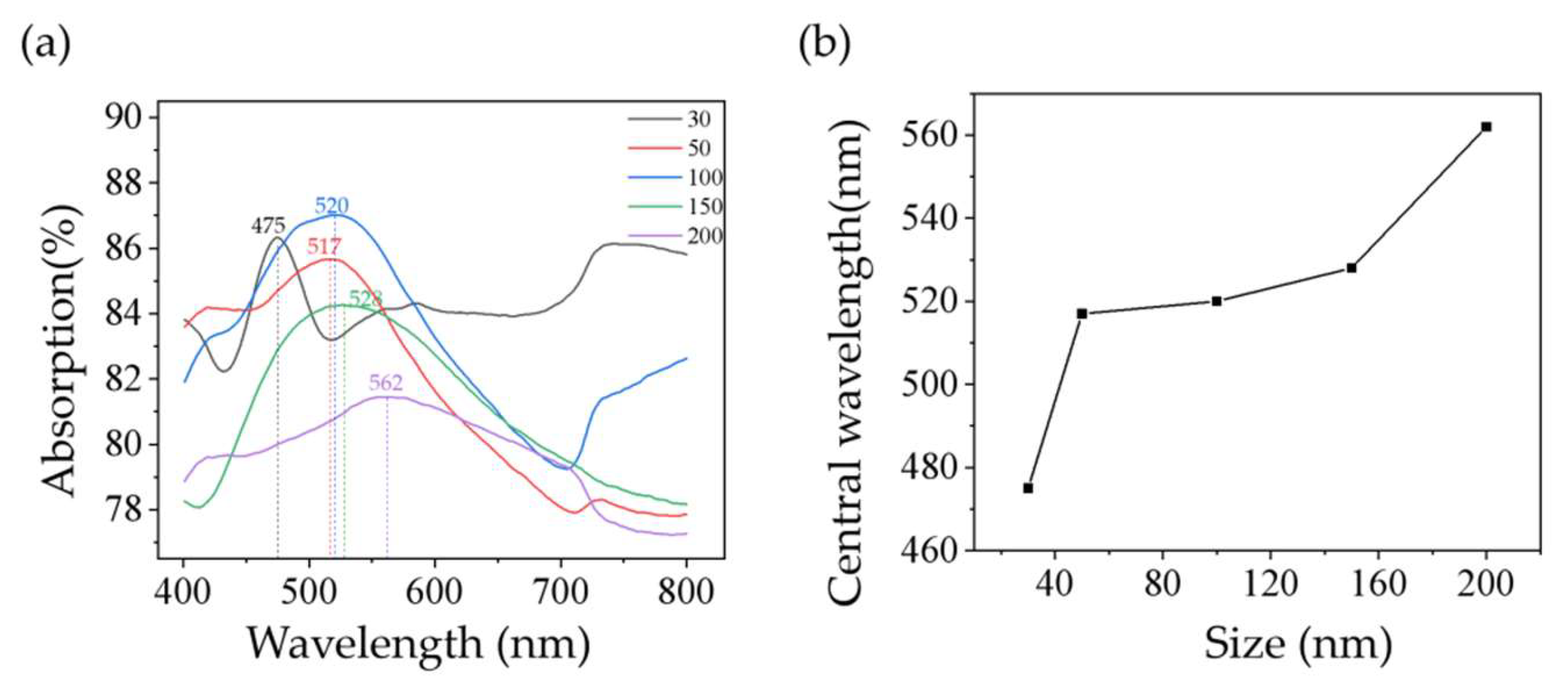


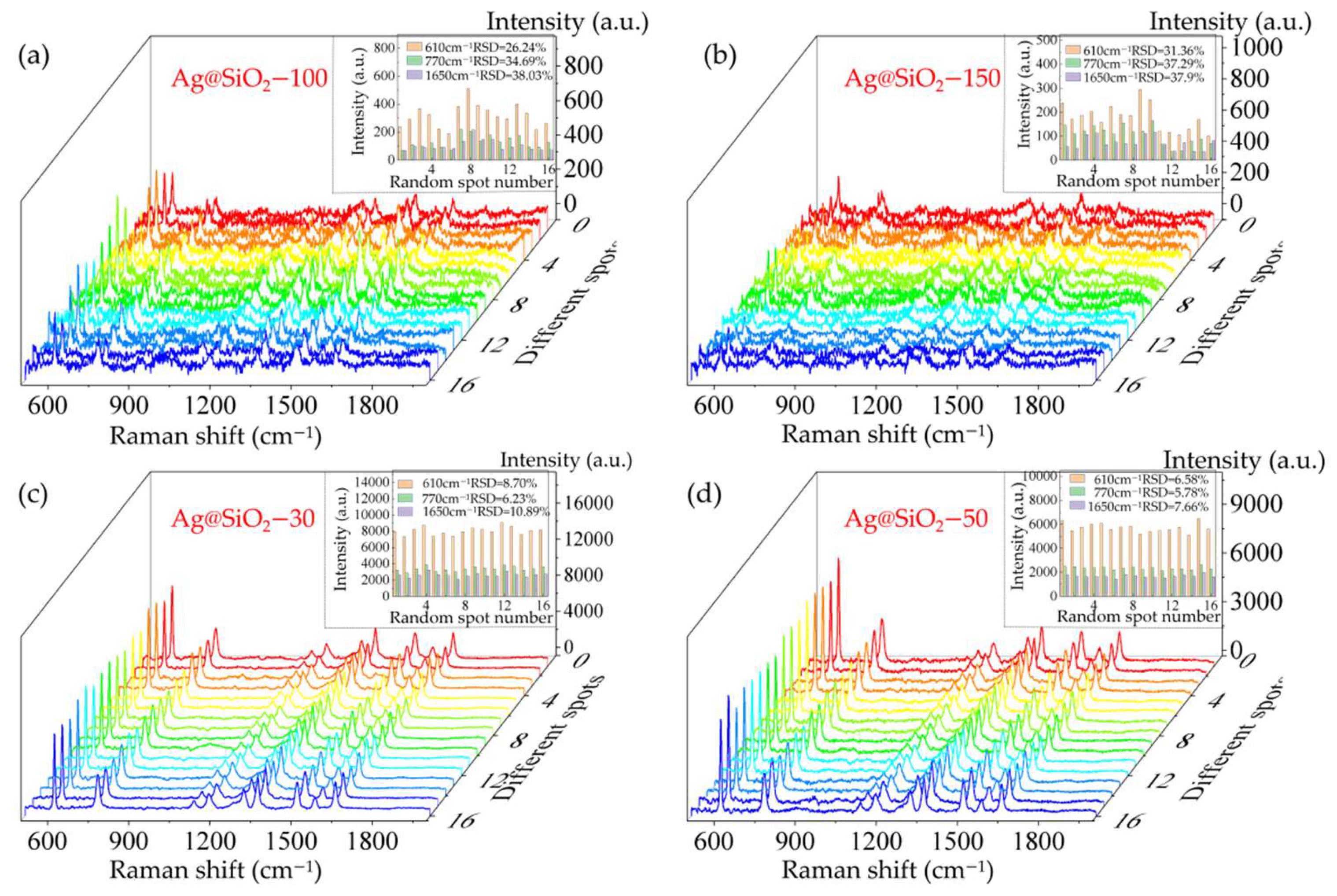
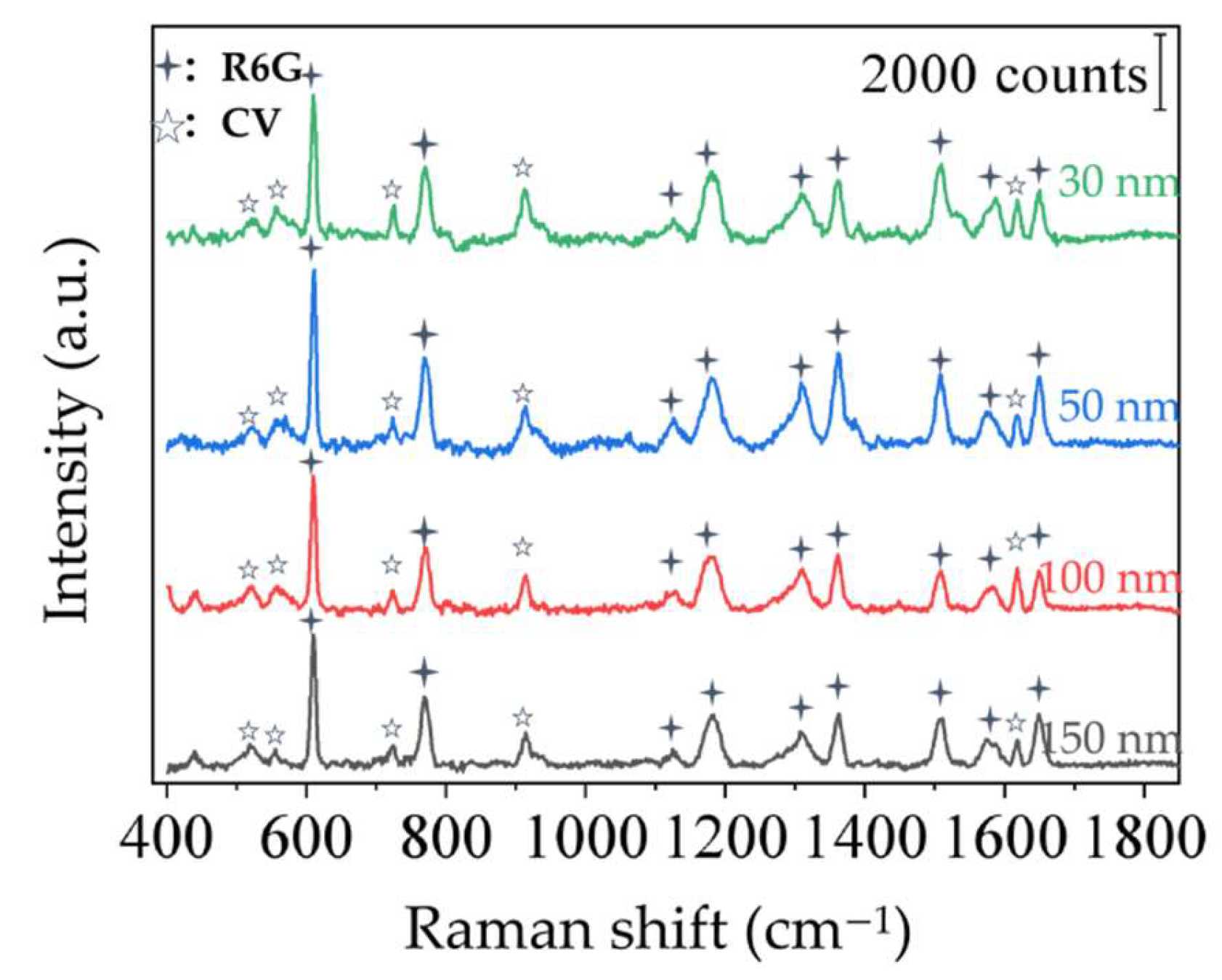
Publisher’s Note: MDPI stays neutral with regard to jurisdictional claims in published maps and institutional affiliations. |
© 2022 by the authors. Licensee MDPI, Basel, Switzerland. This article is an open access article distributed under the terms and conditions of the Creative Commons Attribution (CC BY) license (https://creativecommons.org/licenses/by/4.0/).
Share and Cite
Sha, H.; Wang, Z.; Zhang, J. SiO2 Microsphere Array Coated by Ag Nanoparticles as Raman Enhancement Sensor with High Sensitivity and High Stability. Sensors 2022, 22, 4595. https://doi.org/10.3390/s22124595
Sha H, Wang Z, Zhang J. SiO2 Microsphere Array Coated by Ag Nanoparticles as Raman Enhancement Sensor with High Sensitivity and High Stability. Sensors. 2022; 22(12):4595. https://doi.org/10.3390/s22124595
Chicago/Turabian StyleSha, Haiyang, Zhengkun Wang, and Jie Zhang. 2022. "SiO2 Microsphere Array Coated by Ag Nanoparticles as Raman Enhancement Sensor with High Sensitivity and High Stability" Sensors 22, no. 12: 4595. https://doi.org/10.3390/s22124595




